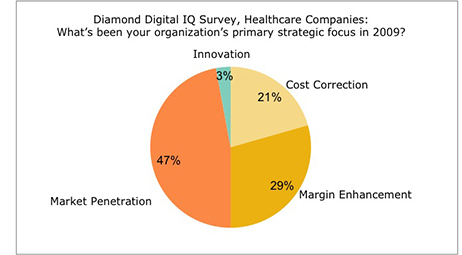In our recent Diamond Digital IQ study, we found that only 3% of healthcare companies were focused on innovation as their primary strategic emphasis. You can empathize that 2009 was a year where many participants in the healthcare cluster were just trying to survive, but, in an industry where costs are rising, care is becoming more complex, and funding sources are in flux, we need more than only 3 in 100 firms focused on innovation. See the figure below.

In this short post, I want to suggest a small number of innovations which could be enabled by iPads and other new mobile technology.
Let's reinvent patient education and use all that waiting time! There are already over 700 applications for the iPad. Many of them concern diet, disease management, exercise, nutrition, stress reduction and even the Army Ranger handbook. Instead of reading those old magazines, or boring generic brochures, you could actually learn something while you are waiting for your doctor.
Bring the relevant information to the moment of use. Often doctors and nurses need or want information that is a few feet or a few floors away from where the treatment is being practiced -- and they cannot afford the time to track it down. The provision of medical care is a very complex "manufacturing process". The specialty talent -- doctors & nurses -- have to have their unique equipment, from blood vials to ultrasound machines -- nearby, and all treatments, opinions, and equipment use need to be logged into the patient's record. Furthermore, this body of information needs to be passed from shift to shift -- flawlessly. Because the iPad is high resolution, easy to use, and chic (not geek), it has a chance of being the tablet device that doctors, nurses and patients can use to help bring the relevant information to the point of need. If the information can be digital first, it has more chance of being well recorded and shared.
Tag everything. How many times have you been in a doctor's office or hospital when they cannot find the relevant person, equipment or information. A friend of mine put sensors into a community hospital -- tagging everything in the operating room, pre-op and post-op. This meant that the scheduling team could see where all the doctors, nurses, devices and other assets were -- in real time. This ability to act more like a modern air traffic controller increased the throughput of the organization's operating suites by 25%, simply by better coordination.
Use video to tell the story. Unfortunately my children have had a number of operations, and I have listened to many surgeons draw their procedures on the whiteboard -- with their minimal drawing skills, and explain the procedure to come. I would have much preferred if I could have watched a simple video, with some illustrations, to show what they intended to do. With the easy video capture on today's technology, cheap and extremely capable editing software, and graduate students who could make the videos -- it seems to me time to create a better library of visual content. Check out the high definition cardio vascular system iPad application. It gives mind blowing detail of how your heart and vascular systems work. Applications like these are just the beginning.
Create a social space for the coordination of care. In the care of an individual there are many, many people who usually need to understand status, take responsibility for part of the care, and report results. Sharing status of results, plans and status of the patient -- to those authorized to look -- could save a lot of headache and heartache. Why can't my relative's status be tweeted to me?
Follow the patient home. Non-compliance to drugs and treatments after the hospital visit are a huge issue. The majority of patients take their medicines incorrectly, and many people are not sure of their post-operative, or post-visit instructions. Soon touchable, portable devices will be cheap enough to give them a device as they leave so that the hospital staff can keep the communication channel open and monitor their compliance to advice, saving lives, time and money.
There are many other potential applications that could help healthcare bend their cost curve. Now is the time to start innovating, and mobile has a chance to reinvent the interaction of the doctor, care givers, family and patient.
Other useful links:
- Diamond's 2010 Digital IQ Study Interactive Site: test your industry's Digital IQ!
- iPad: The Remote Control for Everything?
- iPad in the Enterprise: Will CIOs Use It To Innovate for Customers?
- Sales Reinvention: Why the iPad is a person to person innovation.
- How the iPad is Like a Tesla Roadster